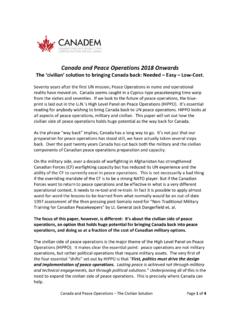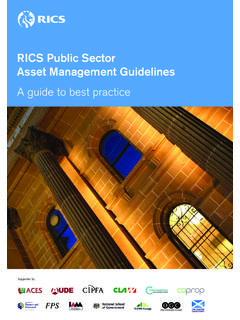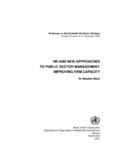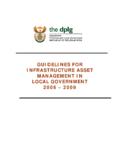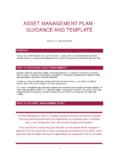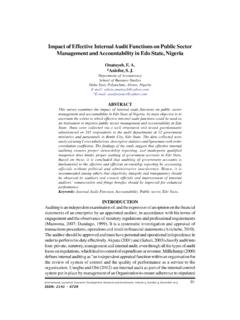Transcription of Public Sector Financial Management for Managers reformat …
1 Public Sector Financial Management for Managers Andrew Graham School of Policy Studies, Queens s University Kingston, Canada November 2011 Public Sector Financial Management for Managers Acknowledgement Public Sector Financial Management for Managers has been produced for the Canadian Governance Support Office with funding from the Canadian International Development Agency, Government of Canada, as a general guide for Financial Management for line Managers in the Afghanistan Public service. It can be freely reproduced by any Afghan Ministry, Government Department or Agency. Please acknowledge the Government of Canada in any reproductions. Use by international organizations requires the express permission of CANADEM. CANADEM 2011 Public Sector Financial Management for Managers Table of Contents Section 1: The Nature of Public Sector Financial Management .. 1 Key Points .. 1 Question 1: What is the Public Sector ?
2 2 5 Key Features: .. 2 Question 2: What is Financial Management ? .. 3 8 Key Features: .. 3 Section 2: Cornerstone One: Allocating Resources Budgets .. 5 Key Points .. 5 The Budget Cycle .. 5 Budget Methodologies .. 6 Organizing Budget Information .. 6 Program Budget of the Ottawa General Hospital for Fiscal Year 2005 .. 8 Traditional Budgeting versus Performance Budgeting .. 10 Section 3: Understanding the Budgetary Process .. 11 Key Points .. 11 Budgets and Planning Cycles .. 11 Elements of an Effective Budget Cycle .. 12 Strategic Planning Phase .. 12 Cost Analysis Phase .. 13 The Role of Revenue in Cost Analysis .. 13 How to Determine Costs .. 13 Fixed and Variable Costs .. 14 Getting Approval to Spend: The Appropriation Process .. 14 Central Agency versus Program Organizations .. 15 The New Versus the Old .. 15 Complexity versus Clarity .. 15 On Budget Versus Off Budget .. 15 Conclusion .. 16 Section 4: Budgeting: Capital Planning.
3 17 Key Points .. 17 Capital Budgets .. 17 Characteristics of Capital Assets .. 17 Public Sector Financial Management for Managers Tools of Capital Planning and Budgeting .. 18 Capital Improvement Plans .. 18 Time Value of Money .. 20 Present Value and Future Value .. 20 Net Present Value .. 22 Risk Assessment .. 22 Examples of Risk Categories in Assessing Capital Asset Risks .. 22 Conclusion .. 23 Section 5: Cornerstone Two: Monitoring Money Managerial Control .. 25 Key Points .. 25 What is Management Control? .. 25 Management Control Framework .. 25 Risk and Risk Management .. 26 Understanding and Defining the Risks .. 27 Control Procedures and Policies .. 28 Who and When to Control .. 28 Who is the Controller? .. 29 Trust and Ethics in Control .. 29 Trust .. 29 Ethics .. 29 Values and Ethics Approaches .. 30 Controllership Capacity Checklist .. 31 Strategic Leadership .. 31 Clear Accountability .. 32 Shared Values & Ethics.
4 32 Mature Risk Management .. 32 Integrated Performance Information .. 32 Motivated People .. 32 Rigorous Stewardship .. 33 Section 6: Cash Management : In Year Control .. 35 Key Points .. 35 Objectives of Effective Cash Management , Monitoring and Control .. 35 Establishing a Cash Management System .. 36 In year Budget Design 37 Public Sector Financial Management for Managers Estimating Work Flows .. 37 Use of Historical Data .. 38 Monitoring Financial Performance and Variance Analysis .. 38 Setting up a Monitoring Timetable .. 39 Governance .. 39 Performance Reports .. 39 Eastbrook Correctional Facility, Eastbrook, Nova Scotia .. 39 Staffing: Plan versus Actual .. 40 Variance Reports .. 40 Forecasted versus Actual Report .. 40 Analysis of Key Variances Report .. 40 Historical Information .. 41 Historical Staffing Patterns: Custodial Only: Year Average .. 41 Reallocation and Readjustment .. 42 The Authority to Reallocate.
5 42 Freeing Up the Funds .. 42 Conclusion .. 43 Section 7: Cornerstone Three: Reporting On How Money Is Spent Accounting .. 44 Key Points .. 44 Accounting Principles .. 44 1. The Entity Principle .. 44 2. Money as a Measure/ the Cost Principle .. 45 3. The Going Concern Principle .. 45 4. The Conservatism and Cost Concept .. 45 5. The Matching Principle .. 46 6. The Consistency Principle .. 46 7. The Materiality Principle .. 46 8. The Duality Principle .. 46 9. The Accrual Principle .. 47 The Quality of Information .. 47 The Outputs of Accounting .. 48 The Accounting Cycle .. 48 Double Entry Bookkeeping and the Fundamental Accounting Equation .. 48 Debits and Credits .. 49 Examples of Debits and Credits Transactions .. 49 Public Sector Financial Management for Managers Where are these activities actually recorded? .. 50 Key Definitions of Terms Used In Financial Statements .. 50 An Example of Depreciation .. 52 Equity/Net Assets/Fund Balance.
6 53 The Balance Sheet .. 53 The Income Statement .. 54 By Object: salaries, benefits, rentals, cost of services .. 54 Income Statement Organized by Object (Plus Year to Year Comparison) .. 54 The Statement of Cash Flows .. 54 Conclusion .. 55 Section 8: Accrual Accounting: Providing a Fuller Story .. 56 Key Points .. 56 Why do we need Accrual Accounting? .. 56 Cash Basis Accounting: An Overview .. 57 Another Example of Cash Accounting .. 57 Example of Cash Accounting .. 57 Accrual Basis Accounting: An Overview .. 57 Example of Accrual Accounting .. 58 The Difference between Cash and Accrual Accounting .. 58 Cash Versus Accrual Treatment of Asset Acquisition and Use .. 59 Implications of the Accrual Accounting .. 59 An Example of a Week in the Life of One Government .. 60 Financial Reports of the Government .. 61 The Pros and Cons of Cash and Accrual Accounting and Budgeting .. 62 Conclusions and Overview .. 64 Section 9: Accountability and Reporting.
7 65 Key Points .. 65 What is Accountability? .. 65 The Relationship of Accountability and Financial Management .. 66 The Users of Financial and Performance Reports .. 67 The Objectives of Financial and Performance Reporting .. 68 The Role of Audit in the Accountability Process .. 69 Internal Audit Functions .. 69 Legislative Auditors .. 70 Public Sector Financial Management for Managers Independence .. 70 Reporting to the Legislature .. 70 Third Party Accountability and the Burden of Oversight .. 71 Conclusion .. 73 KeyThe Pachieand e Whilecapac FinanmoneMana ThesevarioPublic SectSectioy Points Public sectoreve a range the term recity, in the encial Manageey in a systeagement has Resource Controlle Accountae 3 Cornerstus parts, whtor Financial Mn 1: Ther is responsibof Public goo esources emend, each of ement is an matic, efficis 3 CornerstAllocation (d Delivery (Sbility (Reportones of Pubhich will be eAManagement e NatureManble for bringods.)))
8 This resmbraces manthese involvimportant toent, transpatones: Getting MonSpending Morting on Monblic Sector Finexplored in dCoDelMaAccountingReportingand Auditfor Managerse of Pubnagemenging togetheponsibility cny elements,ve money. ool that helparent, and leney), oney), and ney). nancial Mandetailed throResAlloBudontrolled ivery: Riskanagementg: g ts lic Sectont r large amoucomes with c, people, timps the Publicgitimate wanagement caoughout thissource ocation: dgetingk t or Finanunts of resouconsiderableme, attentionc Sector takey. Public secn be brokens guide. We c ncial urces to e complexityn, focus, ande care of ctor Financian down into can begin to1 y d al o Public Sector Financial Management for Managers 2 identify some of the components of these three broad stages by asking the questions: What is the Public Sector , and what is Financial Management ?
9 Question 1: What is the Public Sector ? Summary: The Public Sector needs to work within specific Financial boundaries while trying to solve problems affecting the citizens it represents and serves. 5 Key Features1: i) The Public Sector is broad. It encompasses all organizations that receive their funding from Public sources such as taxes, fees or licences. Therefore, it will embrace not just government departments, but also government enterprises. ii) The Public Sector has multiple goals. Rather than having a single bottom line, the Public Sector has several, which are being pursued at once. iii) The Public Sector uses various tools to reach it are a series of instruments used to achieve the goals of government2. iv) ThePublic Sector often uses the Private Sector to deliver Public Goods. Modern governments frequently use contracts with private corporations as a means of acquiring needed expertise, outsourcing work, or extending their workforces while seeming to contain the growth of the Public service.
10 This contracted work does not mean that the regular Public service is relieved of its accountability for Public funds. Governments devote considerable energy to administering contracts, especially during a period of increased scrutiny by the Public and by the contracting community in particular. v) The Public Sector is a democratic institution. Governments own none of the resources they spend. Taxpayers do. In a democratic society, the ways in which governments spend resources must be transparent and readily open to questioning. Accounting for Public Sector funds and their proper expenditure is not only part of good Management , it is essential to good government and good governance of the Public enterprise. It is also where governments are most heavily scrutinized and where they can get into a great deal of trouble. Such scrutiny is one of the basis of a government s legitimacy. 1 CICA Public Sector Accounting Handbook, Revised Update No.
